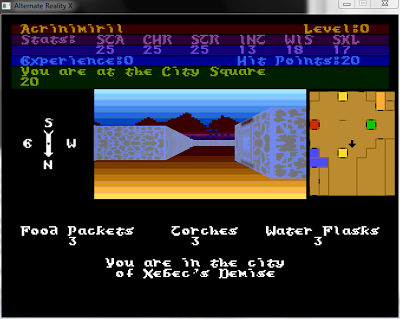
Category: Uncategorised

PC disaster
disaster struck on Friday evening – I came back to my pc after a few pminutes and found that it was dead. Hopefully just temporary – it appears that it might be a power supply failure so I’m hoping I might be able pick up a suitable old one on Monday.
Of course I just happen to have my sons school project on there and my recent version of ARX with no recent backup. Hope to get this sorted on Monday or at least swap the hard drive into a another pc suo I can copy off these files.

Alternate Reality – Automapping
I’ve talked about adding an automap to ARX before and decided I will try and add one into the next release. This will mean a delay in the next release but hopefully the feature will be seen as a positive addition. The original Dungeon game didn’t have an automap but it did feature an item known as the Map stone which when used revealed your x and y location.
I think a game like ARX will really benefit from an automap and it could also be useful as a means of teleporting about the map or editing map layouts in the future. Maps vary in size from 64×64 cells to 8×8 so the automap needs to accomodate these. There are likely to be two views for the automap:
- Full screen view which will display the whole (or most of) the current map
- Mini map view located alongside the 3D view
 |
| The northeast corner of Dungeon level 1 |

Alternate Reality X – Release 2.1
After taking almost a year between the first and second demo releases for Alternate Reality X (ARX), I’ve vowed to release updated versions more frequently. However I have been really busy with work and been away on holiday so I’ve made very little progress since the demo release at the beginning of August 2010.
I have started working on the City character creation and now have it at the point that it’s mostly complete. I still need to fix a few things such as the colour of the counters and music / sound effect timing. I’m not attempting to match every element of the original character creation sequence but hopefully people will understand that. I’m rather spend the time on key parts of the game such as combat and shop functionality.
My graphic card issues are now resolved so I have ARX running at about 60 frames a second – much better than the previous 6 frames!
Over at the ARX forums there a number of bug reports which I will try to resolve in the next few days. Possibly the worse is the teleport bug which places you outside the level 2 map. I think this will be due to me using level 1 teleport coordinates when adding the level 2 dungeon map. Thanks to dalimar for pointing these out.
I’m hoping to finish off the city character creation sequence and fix these bugs for a small 2.1 update release sometime this week.
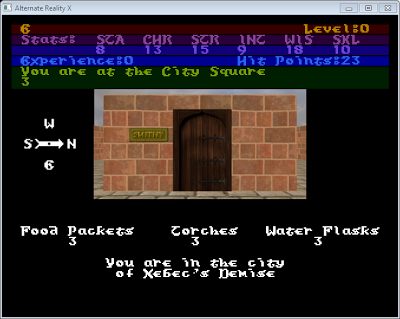
Alternate Reality – Graphic card woes
I was fortunate enough to be able to upgrade the old laptop I was using to a decent spec PC. Everything initially looked very positive. Windows 7 installed smoothly, detected all the right drivers and the PC seemed to perform very well. I installed Visual Studio 2008 Express which I am using to develop my Alternate Reality remake and everything compiled fine.
However when I ran Alternate Reality X (as I’ve now started calling it) but it was very slow. SFML (the media library I’m using for the project) uses OpenGL to produce all its graphic output and I’m also using OpenGL to produce the 3D view in the game. The onboard Intel graphics in the PC obviously doesn’t have proper Windows 7 drivers which support OpenGL (despite the OpenGL logo being displayed within the graphic card driver tab within Windows).
The number 3 on the status bar below indicates the number of frames the game is currently running at with the alternate graphics option. It’s not quite so bad with the original graphics which are smaller dimenstions. On my previous laptop (also using Intel graphics but with proper OpenGL supported Windows 7 drivers) the game ran around 30 frames a second. Sadly there seem to be no better drivers available.
I ordered a new graphics card with an NVidia chipset but didn’t realise that the PC didn’t have a PCI Express x16 slot! I’ll get this sorted eventually. In the meantime I’ll focus on parts of the game which aren’t really affected by the slow speed.
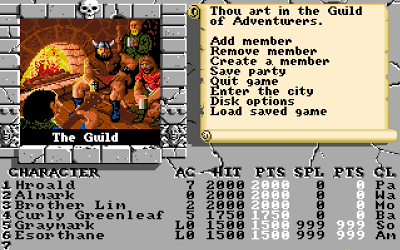
The Bards Tale
I’ve been giving a lot of thought over the last few weeks to the games that I’ve played over the years and the features I want to include in my game. One game that ’ve played quite a lot over the years was the Bards Tale, first on the Commodore 64 and later the Commodore Amiga.
 |
| Bards Tale 2 – The Guild where you create your party (Amiga version) |
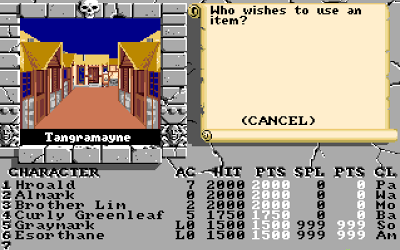 |
| Bards Tale 2 – Exploring the streets of Tangramayne (Amiga version) |
Combat was turn based and almost entirely textual in nature. The party and its enemies initially faced each other from a distance before advancing into range for combat. Only the first four characters in your party could attack hand to hand with the others having to rely on magic or missile weapons to attack from a distance. Magic played a big part in the game with a number of different types of magic user, some of which could only be accessed when a certain level of proficiency had been reached. One unique class within the Bards Tale was the Bard of the title who could play a number of tunes which produced magic – providing you made sure he had plenty to drink at the tavern.
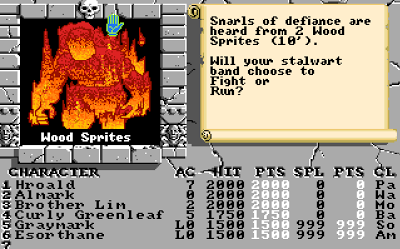 |
| Bards Tale 2 – Combat (Amiga version) |
It was possible for you to encounter wandering monsters who offered to join and fight for the party. I also like the layout and interface for the game which I think is very clear and easy to understand. I’d imagine my CRPG will have a similar type of layout where you can always see how your party members are holding up – nothing worse than not being able to see if a character will last another round.
My new CRPG project
I think the first Computer Role Playing Game (CRPG) I ever played was Ultima IV: The Quest of the Avatar on my Commodore 64. I was only about 12 years old at the time and Ultima IV wasn’t readily available in the UK at the time. Fortunately my Uncle worked with someone who had a lot of American imports of new games and I obtained a loan of Ultima IV from him. Whilst the graphics were simplistic (even back then!) I soon found myself drawn into the game and the story. I’ve since found the CRPG genre to be my favorite type of game. As well as the Ultima series other favorites included the Bards Tale and Alternate Reality: The Dungeon. Later when I upgraded to an Amiga I played Dungeon Master, Eye of the Beholder and Ultima VI. Finally I got access to a PC. These old games used a variety of different styles of play and features to create their fantasy worlds despite the limited platforms that they ran on. However, despite their dated graphics and limitations I often find myself drawn back to these games and their conventions. I think there is a certain charm and entertainment value about these early CRPGs that many newer games have failed to capture or build on.
Ever since I received my first home computer I wanted to design and create my own Computer Role Playing Game (CRPG) such as those that were popular for the 8bit and 16bit computers of my youth. I designed many games over the years (mainly on paper) but never managed to take one of those designs and implement it as a playable game. Twenty years later and there are a wealth of programming languages and gaming resources available for free on the Internet. In addition my programming skills are much better than they used to be (though still not great). I’m now keen to design and develop my own “Classic” CRPG, incorporating my favorite design features and ideas from my years of playing CRPGs. Hopefully along the way I’ll add a few good ideas of my own and maybe even create a game that some people might be interested in playing! I’ll record my design ideas and progress as the game develops. In addition I’m planning to play a lot of the old games through for inspiration and plan to record my experiences about these from time to time. I’ve never actually finished very many CRPGs that I’ve played and there are a number I’d like to finish. I think I probably spent most of my time designing rather than playing.
I will be developing the game initially under Windows using Microsoft Visual Studio Express, C++ and the Simple, Fast, Multimedia Library (SFML). This library has proved powerful but relatively easy to use in the past. Eventually I would expect to be able to offer Linux and Mac versions as SFML is supported for both platforms. However I still have only a vague idea of what the design and content of the game is likely to be at this early stage.

